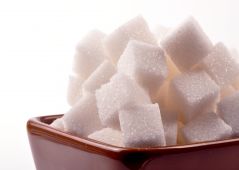Sugars

What are sugars?
Sugars are the basic building blocks of carbohydrates found in nature; they can be found in milk, tree saps such as maple syrup and many fruits and vegetables.
The most common sugars found in foods are the single sugars called monosaccharides e.g. glucose, fructose and galactose and the double sugars called disaccharides e.g. sucrose (table sugar), lactose (milk sugar) and maltose.
What are the functions of sugars?
- Sweetness: The main functions of sugar is to give sweetness and to provide energy. Food examples: Baked goods, sweets
- Taste and aroma: Sugar can enhance not only sweet fruity flavours but also others such as vegetables and meat even without making them sweet. Food examples: breads, fruit products, beverages
- Volume: In breads, sugar increases volume through the process of fermentation. The reaction of yeast breaking down sugars produces various components including carbon dioxide gas which increases the volume of the bread. In other baked goods where yeast is absent (e.g. cupcakes), sugar creates bulk whilst maintaining its physical appearance. If the amount of sugar was reduced, extra fats is usually added. Food examples: baked goods
- Texture: Sugar plays a role in texture by providing texture and consistency. It is important to have the correct balance between sugar and other ingredients (e.g. pectin, water etc) in certain products to achieve the desired texture. For example in making jams, too much sugar may cause crystallisation while not enough sugar may result in the failure of the gelling process. Food examples: breads, jam, boiled sweets
- Reducing the freezing point: Higher sugar concentration results in the lowering of freezing point, which plays a role in preventing the formation of large ice crystals. This is important in ice cream and frozen desserts where small ice crystals are preferred to achieve the desired sensation in the mouth hence taste. Food examples: ice cream and frozen desserts
- Shelf life: Pathogenic microorganisms need water to grow. Sugar binds water in foods. So if the concentration of sugar is increased to a certain level, all water is bound by the sugars, giving no space for microorganisms to grow. This will then increase the shelf life of that product. Food examples: pickled products, jams.
- Colour: Sugar gives colour to foods through various ways: caramelisation (occurs when a sugar solution is heated above 100C, e.g. confectionery products), Maillard reaction (the reaction between sugar and amino acids, e.g. breads, coffee) and by preserving colour (e.g. jams and marmalades).
- Fermentation: Sugar helps the fermentation process (in breads for example) by kick-starting the yeast in producing carbon dioxide gas, which gives rise to the volume as discussed previously.
Is sugar bad for you?
We all need sugars (or so called carbohydrates) as the main source of energy. We cannot completely remove sugar from our diet, because it functions much more than just giving sweetness as discussed in the previous section. Of course, long-term excessive sugar intake may lead to lifestyle diseases (e.g. type 2 diabetes) and dental caries. So it is okay to consume sugar within its recommended level.
How do I know how much sugar is contained in a food? Try out our experiment.
More information
TED Ed: How do carbohydrates impact your health?
IFST food science fact sheet: Sugars


